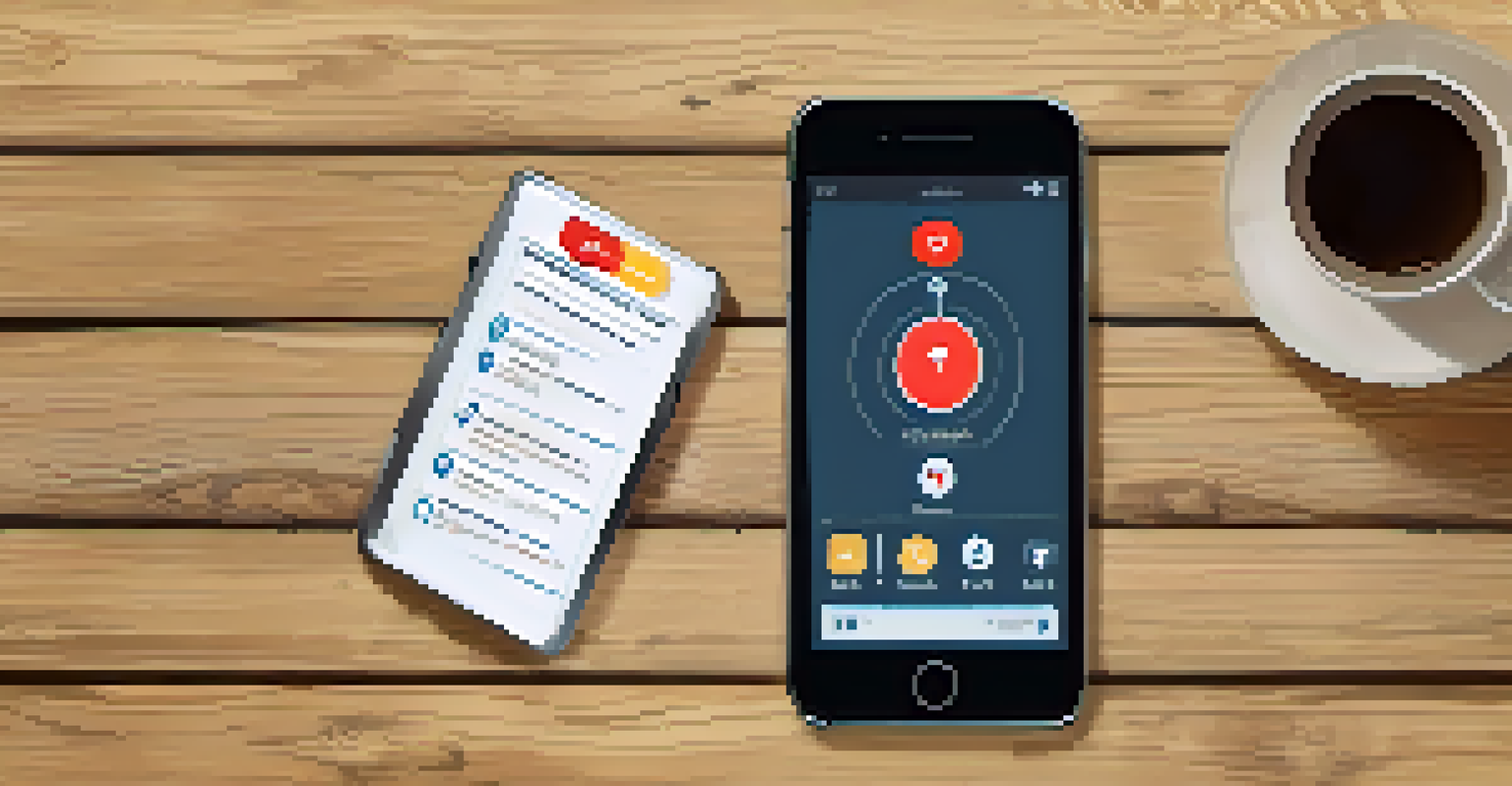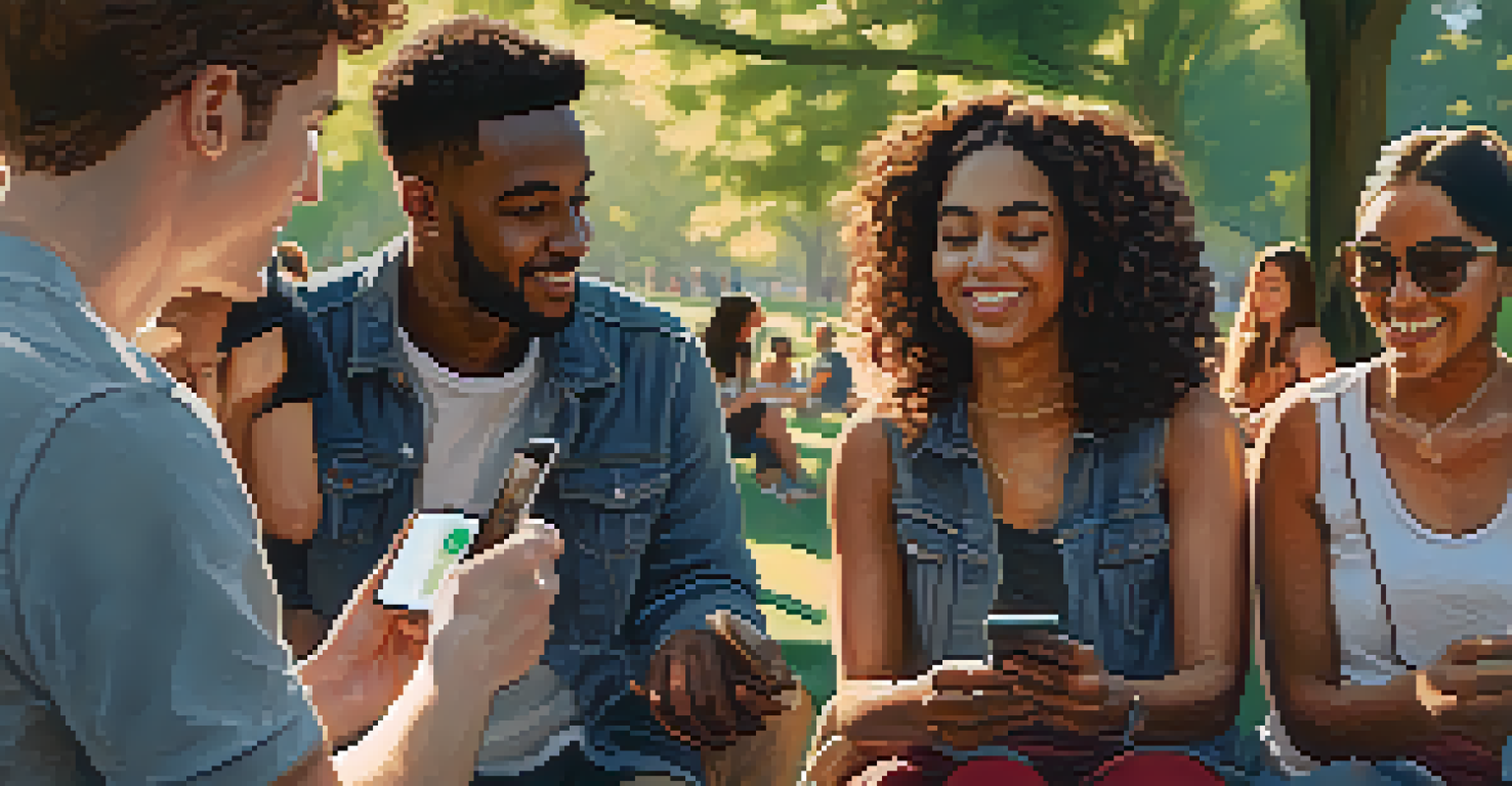The Rise of Personal Safety Apps in Modern Society

Understanding Personal Safety Apps and Their Purpose
Personal safety apps are mobile applications designed to enhance individual security and provide peace of mind. They often include features like location tracking, emergency alerts, and direct connections to local authorities. As technology advances, these apps are becoming more sophisticated, integrating with smart devices and utilizing real-time data.
Safety isn't expensive, it's priceless.
The primary goal of these apps is to empower users to take control of their personal safety. By providing tools that allow for quick communication in emergencies, they help to reduce the feeling of vulnerability that many people experience in today's world. Ultimately, they serve as a digital safety net, helping users navigate risky situations more confidently.
With the rise of smartphones, these apps have become accessible to a wider audience, making personal safety a priority for individuals from all walks of life. Whether you’re a student walking home late or a traveler exploring new areas, these tools are designed to support you every step of the way.
The Impact of Technology on Personal Safety Solutions
Technology plays a crucial role in the effectiveness of personal safety apps. Features such as GPS tracking, automatic location sharing, and panic buttons are now commonplace, making it easier than ever to alert friends or authorities in case of danger. This tech-savvy approach means that users can feel more secure, knowing help is just a tap away.

Moreover, advancements like artificial intelligence (AI) and machine learning are beginning to shape how these apps function. For example, some apps can learn user behavior and send alerts if something seems off, acting as an additional layer of security. This proactive approach is a game-changer, as it anticipates issues before they escalate.
Empowering Personal Safety
Personal safety apps provide essential tools like location tracking and emergency alerts to help users feel more secure in their daily lives.
As society embraces digital solutions, personal safety apps will likely continue to evolve. They not only adapt to new technologies but also respond to emerging safety concerns, ensuring that users have the most relevant tools at their disposal.
The Growing Popularity of Personal Safety Apps
The surge in personal safety app usage can be attributed to rising safety concerns in urban environments. More individuals recognize the importance of being prepared for unexpected situations, leading to a greater demand for these protective tools. This trend is especially noticeable among younger generations, who are more comfortable with technology and seek immediate solutions.
Technology has the power to change the world, but it also has the power to keep us safe.
Additionally, high-profile incidents and social movements focused on safety have heightened awareness about personal security. The visibility of these issues in media and social platforms has motivated many to download safety apps as a precautionary measure. It’s a powerful reminder that personal safety is a universal concern.
As more people become aware of the available options, personal safety apps are increasingly viewed as essential tools rather than optional downloads. This shift represents a cultural change where prioritizing safety is becoming the norm.
Key Features That Make Safety Apps Effective
Effective personal safety apps typically offer a combination of features that cater to various safety needs. For instance, real-time location sharing allows users to let friends or family track their whereabouts, which can be crucial during late-night outings. Panic buttons, which can alert authorities or designated contacts, provide a direct line of communication in emergencies.
Other valuable features include safety check-ins, which encourage users to notify someone when they reach a destination safely. Additionally, in-app resources like crime maps or safety tips enhance users' awareness of their surroundings. These elements work together to create a comprehensive safety solution.
Technology Enhances Security
Innovations such as GPS tracking and AI integration make personal safety apps more effective by enabling quick responses to potential dangers.
Moreover, user-friendly interfaces ensure that even those who may not be tech-savvy can navigate the app easily in stressful situations. The right combination of features can significantly improve an app's effectiveness, making it a vital part of a user's safety toolkit.
Challenges and Limitations of Personal Safety Apps
Despite their benefits, personal safety apps do face challenges and limitations. One major concern is the reliance on technology; if a user’s phone battery dies or they lose signal, the app may become ineffective. This raises questions about the reliability of digital solutions in critical moments when they are needed most.
Privacy and data security are also significant issues. Many apps require location data and personal information to function effectively, which can lead to concerns about how this data is stored and shared. Users must weigh the benefits of safety features against potential privacy risks, making informed choices about which apps to use.
Additionally, while these apps can enhance personal safety, they should not be seen as a substitute for broader social changes and community safety efforts. It’s important that users understand the limitations of technology and continue to advocate for safer environments in their communities.
The Future of Personal Safety Apps
Looking ahead, the future of personal safety apps appears promising, with innovations on the horizon that could further enhance user safety. For example, integrating wearable technology could allow for even quicker responses in emergencies, as these devices typically stay on the user regardless of their phone’s status. This connectivity can create a seamless safety experience.
Moreover, partnerships with local law enforcement and emergency services may become more common, allowing for faster response times and better communication during crises. As these collaborations grow, users may benefit from a more integrated approach to personal safety.
Evolving Safety Solutions
As safety concerns rise, personal safety apps are increasingly seen as vital resources, reflecting a cultural shift towards prioritizing individual security.
As societal attitudes toward safety continue to evolve, we can expect personal safety apps to adapt and expand their offerings. With a focus on user feedback and technological advancements, the next generation of safety apps will likely be more responsive, intuitive, and effective than ever before.
Conclusion: Embracing Personal Safety in a Digital Age
In conclusion, personal safety apps are becoming an essential aspect of modern life, reflecting a growing awareness of the importance of individual security. By leveraging technology, these apps provide users with tools that empower them to take control of their safety in a way that feels accessible and manageable. As they continue to evolve, they can adapt to meet changing needs and societal concerns.
However, it’s crucial for users to remain informed about the limitations and challenges these apps present. Balancing technological solutions with community engagement and advocacy will be key to creating safer environments for everyone. Personal safety is a collective responsibility that extends beyond app usage.

Ultimately, embracing personal safety apps signifies a proactive approach to well-being in an increasingly uncertain world. As we adapt to our digital age, these tools can serve not only as a safeguard but also as a reminder to prioritize our and others' safety in our everyday lives.